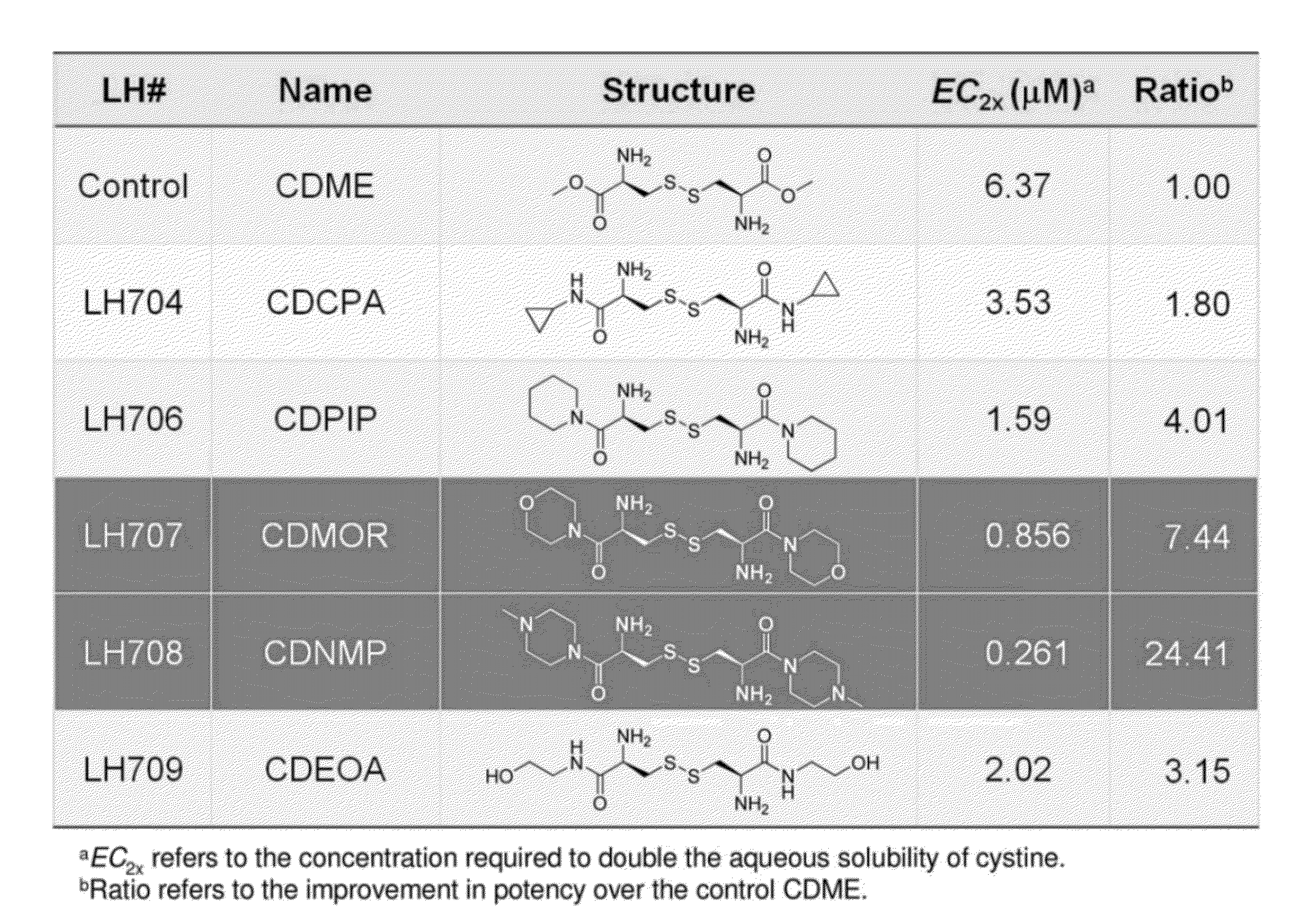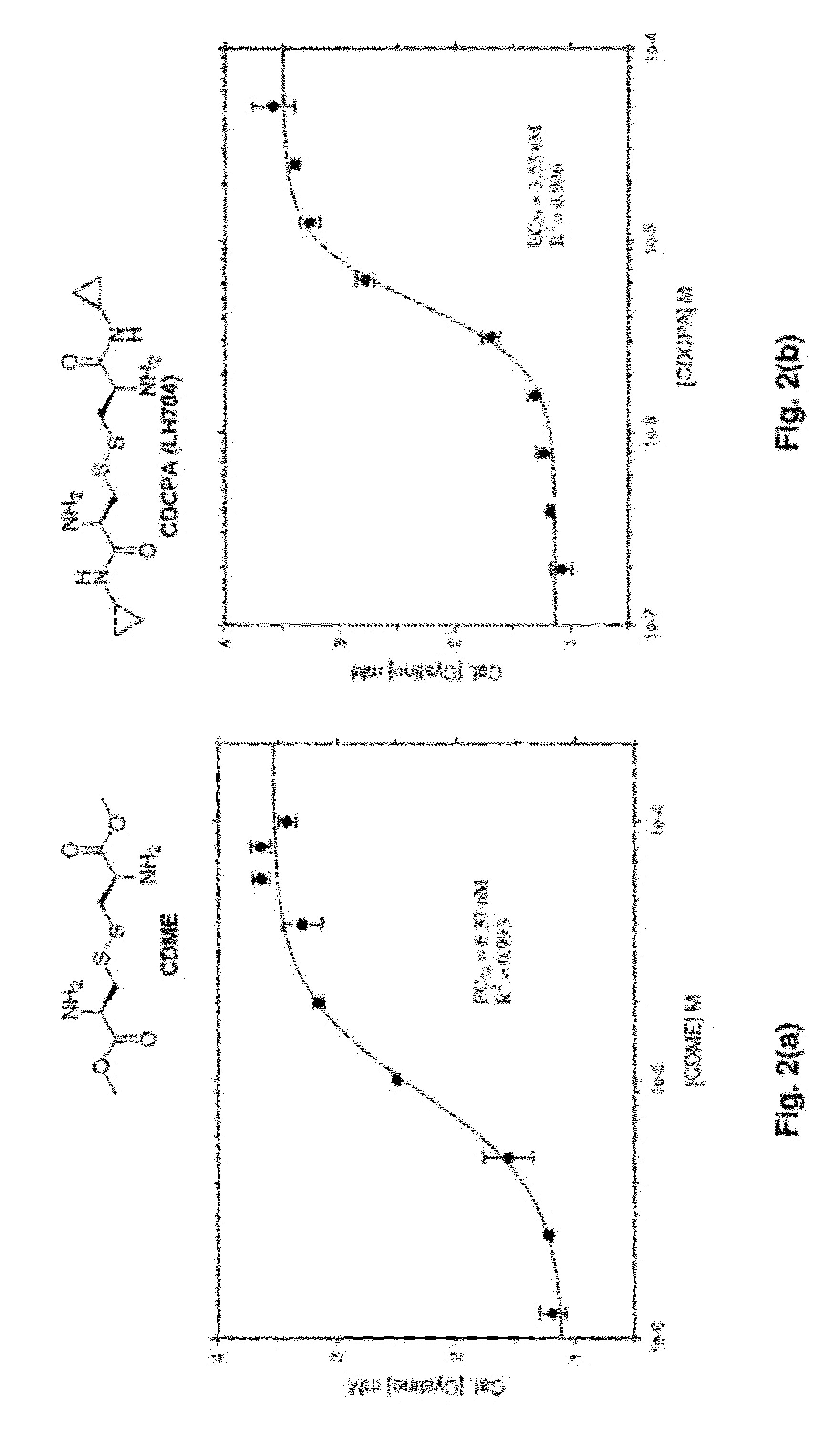Cystine Diamide Analogs for the Prevention of Cystine Stone Formation in Cystinuria
- Summary
- Abstract
- Description
- Claims
- Application Information
AI Technical Summary
Benefits of technology
Problems solved by technology
Method used
Image
Examples
example 1
Experimental Synthesis of L-Cystine Diamides (I-IX)
[0098]NHS (1.7 g, 15.0 mmol) and DCC (3.1 g, 15.0 mmol) were added the solution of N,N′-bis(tert-butoxycarbonyl)-L-cystine (3.0 g, 6.8 mmol) in ethyl acetate (200 mL), and the mixture was stirred at r.t. for 2 hr. After the filtration, the liquid was concentrated and dissolved in anhydrous DCM. After filtration to remove the DCU precipitates, the solvent was removed under reduced pressure to give the crude activated ester as a white solid (2.1 g. 48.6%), which was used without further purification. Similarly, HOBt and EDC can be used to prepare N,N′-Bis(tert-butoxycarbonyl)-L-cystine OBt ester for reaction with amines.
[0099]The activated esters of N,N′-Bis(tert-butoxycarbonyl)-L-cystine were dissolved in a suitable solvent such as acetonitrile, methylene chloride, DMF or NMP. To the solution of an activated ester of N,N′-Bis(tert-butoxycarbonyl)-L-cystine, excess amine (3-10 eq) was added and the reaction was allowed to proceed at r...
example 2
Synthesis of N,N′-dimethyl L-cystine diamides (X-XVI)
[0109]Thiazolidine-4-carboxylic acid (6.66 g, 50 mmol) was dissolved in 60 mL of liquid ammonia at −78° C., to which was added H2O (0.9 mL). Solid sodium was added until the solution remained blue (˜3.8 g). The reaction was quenched with the addition of NH4Cl (11 g, 205.6 mmol), after which the mixture was allowed to warm to room temperature and evaporate overnight. After drying under vacuum, the crude white solid was dissolved in 50 mL of water and acidified to pH 1 with 6 N HCl. The solvent and excess acid were removed under reduced pressure to reveal a sticky off-white solid. The solid was extracted with absolute EtOH, which yielded a sticky yellow solid after removal of the solvent. The N-methylated cysteine was air-oxidized to the disulfide by dissolving in 250 mL of water, at pH 9 (adjusted with ammonium hydroxide), in presence of iron (II) chloride (1 crystal) and bubbling with air overnight. After 13 h, the solution tested...
example 3
Fluorescence Assay for Inhibition of L-Cystine Crystal Formation
[0120]Formation of supersaturation solution—a supersaturated solution was formed by dissolving 21 mg of L-cystine in 30 mL of Millipore water (˜3 mM) under reflux at 100° C. for 20 min until the L-cystine was completely dissolved. The supersaturated solution was then allowed to cool slowly with stirring for 75 min.
[0121]Construction of standard curves—L-Cystine (5 mg) was dissolved in Millipore water (34.7 mL) to form a 0.6 mM solution as a stock solution. Then, L-cystine solution was diluted to 0.4, 0.3, 0.2, 0.1, 0.05 mM solution. 10 uL of each L-cystine solutions, 90 uL of 0.1 M dibasic sodium phosphate solution, and 10 uL of DTT solution (12.5 mM) were mixed at r.t. for 10 min. before the addition of 10 uL of iodoacetic acid (100 mM) and continued incubation at r.t. for an additional 15 min. This was then followed by the addition of 10 uL of OPA (100 mM in methanol) and 10 uL of NBC (100 mM in methanol). The derivat...
PUM
| Property | Measurement | Unit |
|---|---|---|
| Fraction | aaaaa | aaaaa |
| Concentration | aaaaa | aaaaa |
| Structure | aaaaa | aaaaa |
Abstract
Description
Claims
Application Information
 Login to View More
Login to View More - R&D
- Intellectual Property
- Life Sciences
- Materials
- Tech Scout
- Unparalleled Data Quality
- Higher Quality Content
- 60% Fewer Hallucinations
Browse by: Latest US Patents, China's latest patents, Technical Efficacy Thesaurus, Application Domain, Technology Topic, Popular Technical Reports.
© 2025 PatSnap. All rights reserved.Legal|Privacy policy|Modern Slavery Act Transparency Statement|Sitemap|About US| Contact US: help@patsnap.com



